Diamonds are Forever – The Yacht that Swopped Speed for Heavy-Duty Luxury

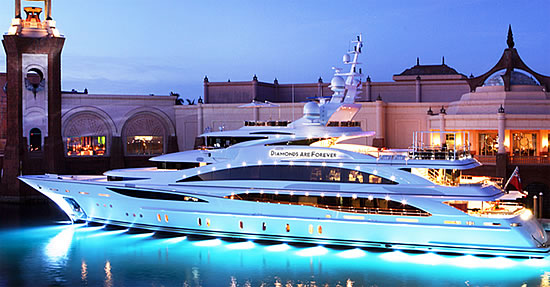
Literally and metaphorically, John Staluppi has spent much of his life with his head in an engine. As a 16 year old mechanic he fell in love with the muscular engines of classic 1950s cars, whose voluptuous forms convey speed, even when standing still. Later his mechanical passion was the basis on which he built an empire of auto dealerships, and of his sideline in super yachts, which he commissions, uses, charters and sells. His success has afforded him the luxury of a private museum, cars of dreams in North palm beach, Florida, filled with angular sedans and undulating soft tops. But a visitor is still most likely to find him out the back, tinkering with a carburetor.
It is no surprise, then, that’s to loopy’s yachting history has been characterized by speed. Among the 17 he has built is the current world record holder for the fastest super yacht–the world is not enough. The surprise comes with his latest project. Diamonds are forever may have a sleek, volume–concealing exterior, with uber–cool shard shaped windows, but she is a 61 m displacement yacht, filled with books to core of the heavy kind.
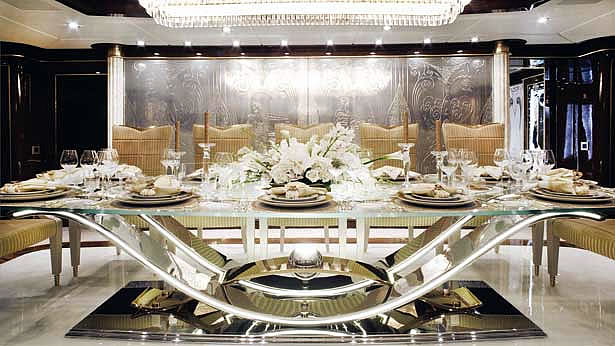
Staluppi and his wife Jeanette were, he says, “tired of worrying about how much the dishes weighed”, so rather than chasing speed, they set out to create the ultimate charter vessel. “I wanted more of a luxury yacht, for cruising–big displacement,” says Staluppi. “On this boat we’ve got a gym, a beauty parlor, a massage area, a sauna–you can’t do that if you want to do 60 knots.”
But for a man as practical as Staluppi, the quest for luxury began with solid basics: a reliable hull. He admired the architecture of Quantum of Solace, a Benetti he’d bought as Midlandia and refitted. So for diamonds, he turned to the Italian builders livorno yard. He initially intended to start from scratch, but the opportunity arose to buy an existing hull and save a year and a half.
“The boat was 50% completed,” says Nicola Nicolai, then head of the project management division at Benetti, now head of sales. “We had all the hard superstructure systems and main machinery work. So he decided to swap from one project to the other, and Staluppi started redesigning completely the boat.”
Nikolai was part of a nucleus of advisors who guided the project from this stage: the others were Peter Thompson, and ocean Independence broker who has worked with Staluppi on previous yachts, and who introduced him to Benetti with quantum of solace, and firmly at the helm, Staluppi himself.
Staluppi’s influence is easiest to see in the heart of the yacht, behind the swim platform and garage; the engine room. He was happy with the parts-built hull’s twin Caterpillar 3512HD engines, with a cruising speed of 15 knots and a top of 16 knots. But he made arresting aesthetic improvements. He brought stainless–steel expert Mike Britton from his car Museum to Italy and now, as Thompson says, “if you can see it, its mirror polished stainless.”
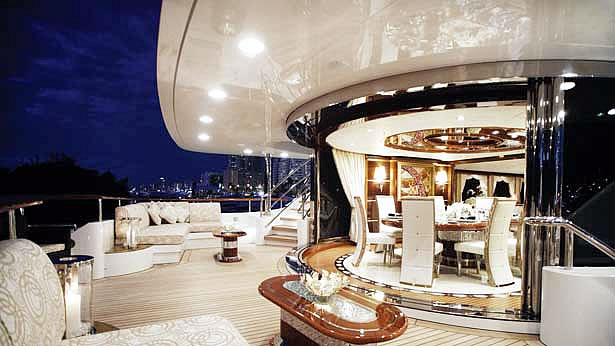
The generators were upgraded, so the emergency unit can now power the whole yacht as normal, except for the zero–speed stabilizers. Foreword, there is a large walk-in fridge and freezer, a good sized laundry room and too generous crew cabins. The hull was laid before the rule forbidding staff quarters below waterline, meaning these take up more of the hall when you would expect in a 2011 launch. Upstairs is the crew mess and five more crew cabins.
Aft, through soundproof doors, the guest areas are fleshed out with Evan K Marshall’s sumptuous decor, installed with the help of Benetti interior coordinator, Domenico Gavagnin. It features glossy words, Art Deco accents and lots of mirrors, while the diamante studs glinting from furniture and fabrics hint at the yachts bond themed name. But these spaces are also inherently practical.
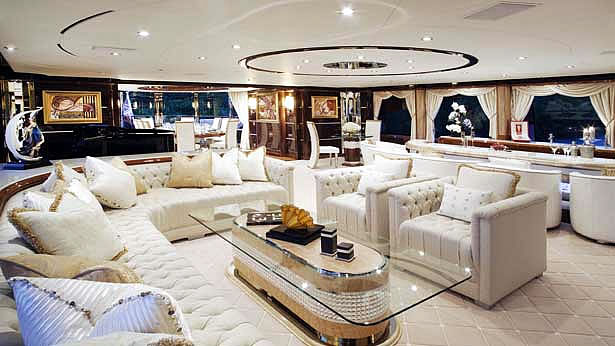
The lower deck guest cabins are a good example of this. The twin and three doubles feature Madrona Burr Woods, gold and silver leaf, and embossed leather bed–heads and marble en suites. But when work began the doubles were designed to fit queen–sized beds. For the US market in particular, King–sized beds were necessary “we found when we were building another yacht with Christiansen that they build right out to the hull, whereas Europeans tend to square things off, so you lose space,” says Thompson.
They pushed out into the unused space, making more usable room without increasing the gross tonnage, which is measured to the hull side.
This practicality was also central to Marshall’s decor. It may be rich and complex, but it doesn’t get in the way. “Art is never a last–minute thing, you’re not walking around saying, “Where shall we hang this painting?” We try to make it integral to the design,” he says.
The central main–deck for your is spectacular but it’s elements are firmly built in. The Onyx floor is centered with a hand–Beaten glass inlay by Dutch company Marieux. Mounted in chrome frames are paintings of sultry women, their jewelry highlighted with diamante studs, while fixed side–tables support Jeanette Staluppi’s Erte sculptures.
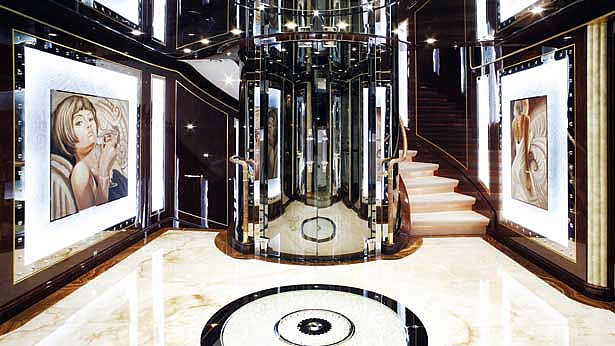
The foyer opens into a main saloon, with similar towns. Towards the end of the room is a spectacular mosaic, flanked by cabinets fronted with chrome backed glass, etched and studded with diamantes used by Marieux.
A central seating area features cream armchairs by Marieux, with apple sized crystals at the ends of the arms. Faux marble pillars separate this space from a dining area with a table designed by Marshall and built by Marieux. It has a glass top and stylized chrome base, accented by a strip of LEDs. Another panel of chrome and glass serves as a backdrop; above it hangs along deco chandelier by Sans Souci of Czech Republic. Its formal luxury executed with the sense of fun.
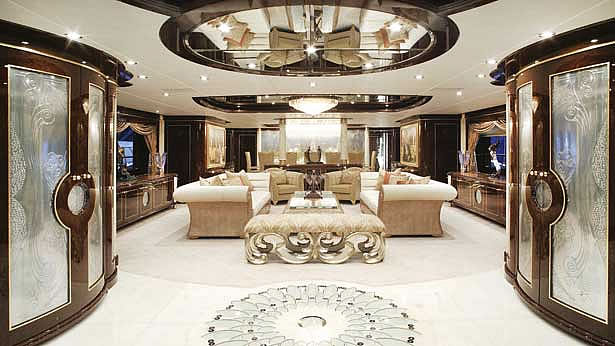
Guests are served from the galley forward, on the other side of the foyer. This space was designed with input from chef Dieter Curth, who has worked on both quantum of solace and a German Navy submarine, where the galley was “the size of a phone booth”.
He works along his “line” with the steam oven, grill and hobbled–all raised to save his back-putting plates on a central island, where stewardesses collect them from the other side, as in a restaurant kitchen. Clever touches include freezer drawers, where Curth keeps small, often used items, such as stocks in ice cube trays. He can open the drawer is frequently without letting cold air out of the freezer.
For those who want to work off Curth’s meals, there is a gym across the corridor or from the galley, plus a sauna and beauty salon with the massage bed. Further forward is the full team, split level VIP suite, which is as grand as the master directly above it. “If two business partners wanted to charter a boat, nobody would say, “which room do I get?” That’s the purpose, says Staluppi.
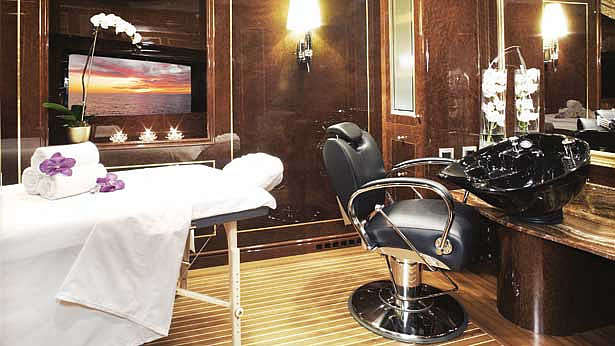
The VIP cabin has 180° views, a cream chaise longue, cream tufted bed basin panelling, and burr wood cabinets, while the gold design on the bedspread is highlighted with diamante’s. Aft on the suites lower level are his and hers dressing rooms and a large marble bathroom. There is also a small night head off the cabin, so guests don’t stumble downstairs in the dark.
The upper deck master suite is slightly larger and the bed faces forward, raised on a platform to enhance the 180° views. It has a similar color scheme to the VIP, a large cream sofa, and Art Line myrtle burr cabinets with crisscrossed mother-of-pearl inlays. The en suite has twin showers, a grand central bath and honey colored marble and Lalique lamps. Aft is a corridor of mirrored wardrobes etched by Marieux and an out-of-the-way study. The suite is a well considered and decadent space.
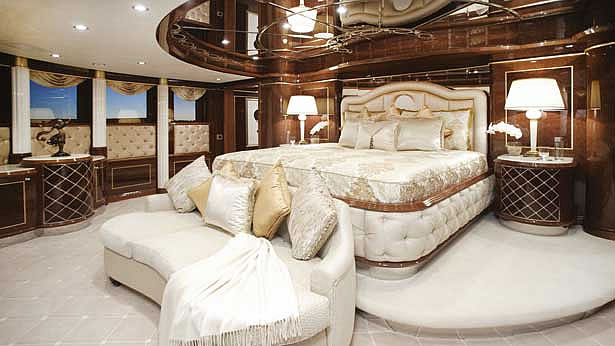
The full beam sky lounge aft feels relaxed and bright–aided by Staluppi’s space planning. “On a previous boat he moves air trunks outside because they blocked windows,” says Marshall “on this vote he did the same. It makes a spectacular difference in terms of space and light.”
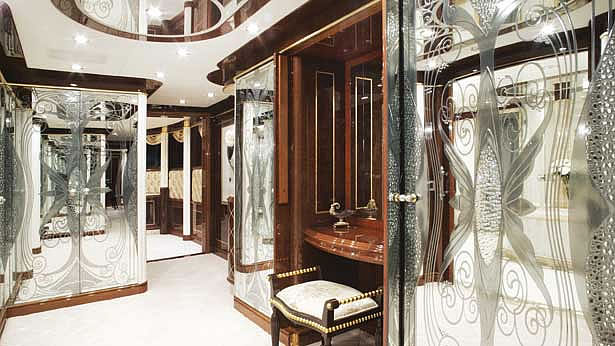
White furniture enhances this airiness and Staluppi insisted on correspondingly pure marble for the top of the wet bar (by Italian expert Guido Manchini and Son). A strip of diamante’s run around the burr base of the coffee table, and of a card table, whose hide backs, white leather chairs pick up the theme with diamante studded spines.
Aft, a circular dining table can be closed off completely from the sky lounge by curved glass doors, while corresponding doors opposite open it up to the aft deck for alfresco dining.
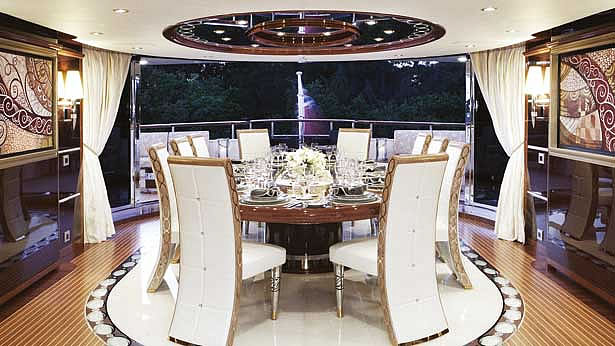
On the sun deck above, a large spa pool overlooks a raise dining area and marble topped wet bar with a television. But Staluppi was just as interested in the design of the pilothouse forward on this deck, which he changed four times to improve its utility. Even further up is the most dramatic alteration Stalluppi made to the boat: the addition of a sky deck. The space is simple, with loungers, a large sofa and the protruding top of the lift, covered in high-gloss wood. It has a feeling of peace and privacy.
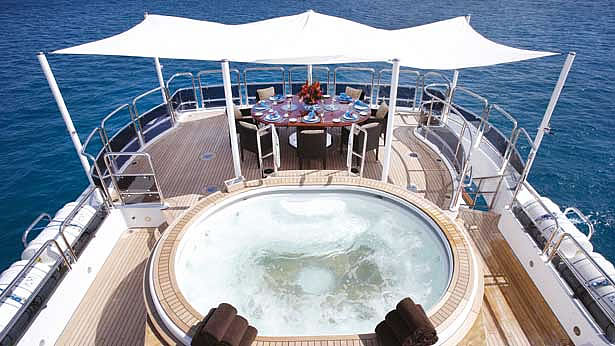
At the opposite end of the boat, 0.3 m was shaved off the keel to ensure the yacht would have a shallow enough draft to cruise the Bahamas. To compensate they upgraded the stabilizers and on the advice of Mike Perkins at Quantum, installed too long fins higher up the hull. The whole package worked well in the Bahamas and on its virgin voyage across the Atlantic to get there.
A Schottel stem thruster was also installed, to help with maneuvering. It runs off its own 400 HP Yanmar diesel, which means the boat can be moved without turning on the main engines.
“All the modifications we have done with Staluppi are an improvement of the standard we have, especially on the technical side. They make the yacht much more functional and we are adopting most of them for all our yachts,” says Nicolai. “Working with Mr. Staluppi has helped Benetti to raise the bar in our quality standards, better understand the requests of the sophisticated US market and build always better products for our clients.”
This effect is something we might expect from a man who loves engines. People who find joy in cogs and nuts working together in harmony tend to appreciate other efficient systems: spaces that work, logical layouts, kitchens that make your food better and your chef happier.
Some of the touches are so small guests may not notice them: aft facing air conditioning drains so when the bow lift’s, gravity pushes water back and out; at the other end of the system, air running through waffle grates with large holes that keep pressure low in quiet; power outlets with both European and American voltages; a refrigerated Atlas electrical system to prevent overheating in tropical climates.
“Systems are important for me,” says Staluppi. “It’s about the whole package and how it’s going to function. I don’t want them to put a pump in that you can’t get to it if the pump breaks. That’s important in a boat.” It is this attention to functionality, rather than her gloss and sparkle, that truly makes this yacht a jewel.
For more information DiamondsYacht


